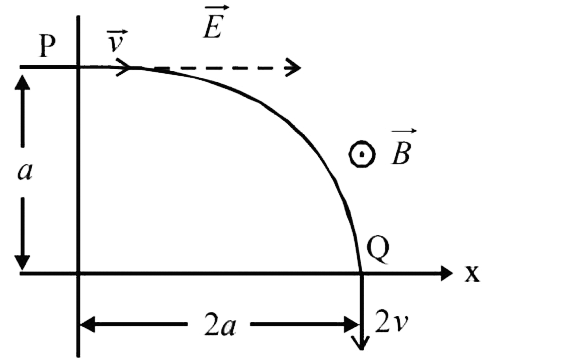A particle of charge +q and mass m moving under the influence of a uniform electric field Eˆi and uniform magnetic field Bˆk follows a trajectory from P→Q as shown in fig. The velocities at PandQ are vˆi and −2vˆj . which of the following statement(s) is/are correct ?

E=34(mv2qa)
The rate of work done by the electric field at P is 34(mv3a)
The rate of work done by the electric field at P is 0.
The rate of work done by both the fields at Q is 0
The correct Answer is:A, B, D
Step by step video, text & image solution for A particle of charge +q and mass m moving under the influence of a uniform electric field E hat(i) and uniform magnetic field B hat(k) follows a trajectory from P to Q as shown in fig. The velocities at P and Q are v hat(i) and - 2v hat(j) . which of the following statement(s) is/are correct ? by Physics experts to help you in doubts & scoring excellent marks in Class 12 exams.
Updated on:21/07/2023Similar Questions
A particle of charge q and mass m starts moving from the origin under the action of an electric field vec E = E_0 hat i and vec B = B_0 hat i with a velocity vec v = v_0 hat j . The speed of the particle will become 2v_0 after a time.
View SolutionA particle of mass m and charge q has and initial velocity →v=υ0ˆj. If an electric field →E=→–––(0)ˆi and magnetic field →B=B0ˆi act on the particle, its speed will double after a time :
View SolutionA particle with a + q charge whose mass m is uniform electric field E hat(i) And a magnetic field B hat(k) Out of, is walking on the projectile path as shown in the picture. P and Q are velocities. Which of the following statements is / are correct?
View SolutionIf →P=ˆi+2ˆj+ˆkand→Q=3ˆi+ˆj−ˆk then →P×→Q is
View SolutionA particle of mass m and charge q has and initial velocity →v=υ0ˆj. If an electric field →E=→–––(0)ˆi and magnetic field →B=B0ˆi act on the particle, its speed will double after a time :
View SolutionA particle of charge +q and mass m moving under the influence of a uniform electric field Eˆi and uniform magnetic field Bˆk follows a trajectory from P→Q as shown in fig. The velocities at PandQ are vˆi and −2vˆj . which of the following statement(s) is/are correct ?

View SolutionA charged particle with charge to mass ratio (qm)=(10)319Ckg−1 enters a uniform magnetic field →B=20ˆi+30ˆj+50ˆkT at time t = 0 with velocity →V=(20ˆi+50ˆj+30ˆk)m/s. Assume that magnetic field exists in large space.
During the further motion of the particle in the magnetic field, the angle between the magnetic field and velocity of the particle
View SolutionA charged particle with charge to mass ratio ((q)/(m)) = (10)^(3)/(19) Ckg^(-1) enters a uniform magnetic field vec(B) = 20 hat(i) + 30 hat(j) + 50 hat(k) T at time t = 0 with velocity vec(V) = (20 hat(i) + 50 hat(j) + 30 hat(k)) m//s . Assume that magnetic field exists in large space. The frequency (in Hz) of the revolution of the particle in cycles per second will be
View Solution

